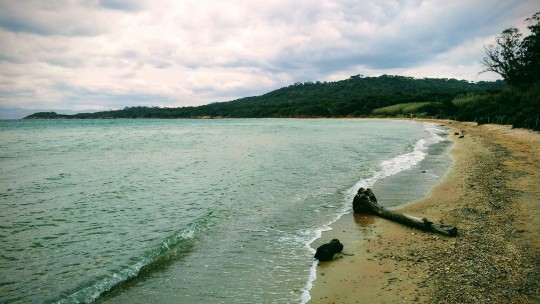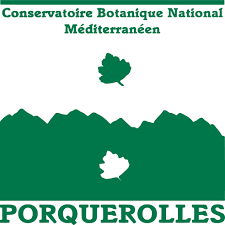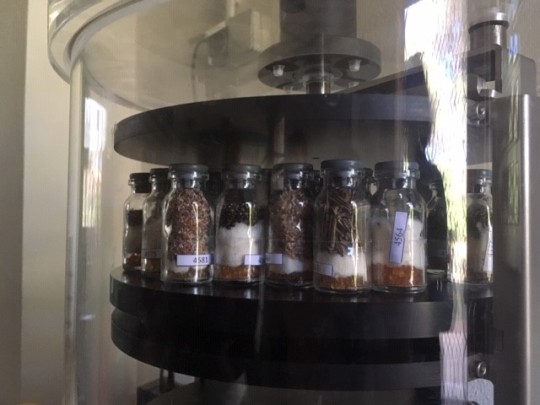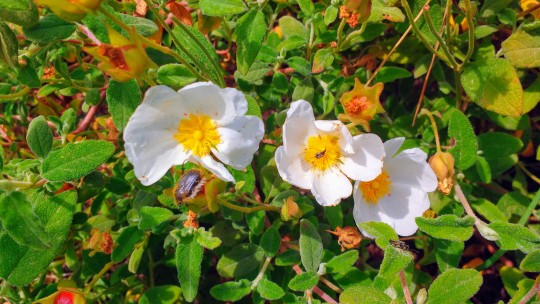by Shaun Turney
From May 19-24, 2019, I attended the International Species Traits Intensive Course in Porquerolles, France. The course is sponsored by the QCBS, along with another Quebec organization, the Centre for Forest Research (CEF-CFR), and the CNRS in France. Porquerolles is a small island in the south of France. There is a tiny, touristic town, but most of the island is a national park and conservation area. The climate in the region is Mediterranean, and the island flora and fauna are more similar to other regions in the Mediterranean Basin than to Northern France. Our classroom was only a few metres away from a beautiful white sand beach and turquoise water.

Tough life, having to take a class steps away from this beach.
Although I managed to squeeze in some time to walk on the beach, we had a very busy schedule. The course lived up to the “intensive” in its title, with class from about 8:30 am to 7:30 pm each day. The course was divided into two main parts: lectures and a group project. Experts in the field of trait-based ecology, Eric Garnier, Alison Munson, Juan Posada, Bill Shipley, Francesco de Bello, Sylvain Delzon, and Elena Kazakou, all delivered informative and engaging lectures over the course of the week. We learned about functional characteristics of plants, trait measurement protocols, response traits along environmental gradients, and functional diversity, to name a few topics. For the group project, I chose to join the group working on seeds traits.
As part of our research, the Seed Team visited the Porquerolles National Botanical Conservatory. I was impressed by the French National Botanical Conservatory system! We learned that seeds of native plant species are collected and stored in seed banks by the numerous Conservatories distributed across France. The stored seeds play a central role in protecting endangered plant species in France because they can be taken out of the seed bank to restore or reinforce wild populations. We “helped” a Conservatory researcher to prepare some seeds, accidentally dropping many of the tiny seeds on the floor. My fingers felt huge trying to remove the husks of seeds roughly the size of mustard seeds, and the task gave me new respect for the amount of work it takes to maintain a seed bank. Finally, we analysed part of their database and found a possible correlation between seed traits and extinction risk.

Logo of the Porquerolles National Botanical Conservatory

Seeds being prepared for storage at the Porquerolles National Botanical Conservatories
The trait-based approach has largely developed in the context of plant ecology, so naturally this course was mostly centred around plants. Usually my interest in ecology lies with animals, especially insects. Throughout the course, I thought a lot about how the observations and theories about species traits that have developed in the context of plants can be applied to animals. I thought of this especially as we were taken on a tour of Porquerolles’ vegetation by a park official. I’ll admit that the plant species names he listed went in one ear and out the other. Instead, I was distracted by all the insects crawling and buzzing around a patch of flowering plants (Cistus salviifolius). Certainly, one interesting interface of plant and animal traits is trait-matching between plants and pollinators. As researchers (including me!) explore these types of questions, future iterations of the course may become less plant-centred.

Cistus salviifolius in Porquerolles. How many insects do you see?
The Species Trait Intensive Course is on its 8th iteration and is usually offered annually. If you’re looking to learn the fundamentals of trait-based ecology, I highly recommend this course.

Shaun Turney is a postdoc in J.P. Lessard’s lab at Concordia University. He recently obtained his PhD from McGill University’s Natural Resource Sciences Department. His research uses insects as study systems to address questions in community ecology and macroecology.

0 Comments